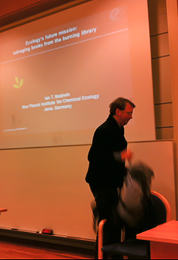The first Lund Biology Seminar starred Ian Baldwin. Those of you that think you do research on a cool system, stop reading now and return to your lab.

Ian was in bad shape, he claimed. A rising fever made him wish he could visit us “with a brain” some time. If his enthusiasm, sense of humour and clarity while presenting resulted from infection, we could however all do with a share of his virus! He introduced his vision to educate “genome-enabled field biologists”, and argued that integrating ecology, evolution, molecular biology and chemistry is a key to future research. Time will tell how right he is. His “research stories” were most certainly both fascinating and convincing.
Plants (Nicotiana attenuata) recognise the spit of caterpillars grazing on them, and upon recognition they release odours that attract insect predators to relieve them from the grazers. The plants also produce chemicals that inhibit the growth of the caterpillars, which is convenient for the attracted insect predators since they are much smaller than the caterpillars. If these tricks do not stop the grazing, the plants change strategy and fix all their carbon in the roots instead of the leaves, and simply wait for the caterpillars to graze and go away. Moreover, the plants produce chemicals that should deter grazing caterpillars. Seemingly at first, these deterrents do not work at all, as the caterpillars actually preferentially go for the structures containing the deterrents. Baldwin’s group has of course disentangled the answer to this too. Caterpillars are able to separate the toxic substances from the sugars in the deterrents, and hence believe they benefit from it. The twist is that odour of caterpillar droppings, containing the toxins, attract ant and lizard predators that efficiently predate on the caterpillars. The plants hence present “evil lollipops” to caterpillars to get rid of them.
Ian nicely demonstrated his use of this model system in his pursuit of educating genome-enableb field biologists, and indicated that the success of such education at least partly lies in the background of students. As I understood it, parents that let their children play outdoors, and also encourage them to study analytical chemistry, would contribute to future research success, as students with such a background are more likely to become genome-enabled field biologists. Potentially, an inconvenient distance between the lab in Jena and the fieldwork area in Utah also contributes by making researchers think carefully before embarking on field investigations.
The presentation was indeed a prominent and delightful start of the Lund Biology Seminar series, and if this seminar sets the standard, we have many fascinating presentations to look forward to.
written by Anders Nilsson
